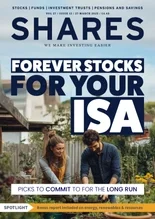Analyst fear overseas repercussions as UK reputation is shattered

It may seem anachronistic in a fast-digitalising world for anyone to hold shares in certificated form, not least because when they are sold it takes ten days to get the cash. But many shrewd investors still make an active decision in favour of share certificates because they know it is a guaranteed way to preserve their rights as a shareholder.
The current system of electronic share ownership, as structured around nominee accounts, is not trusted by this community, even if it affords settlement in three days flat. They argue the system breaks the direct link between shareholder and company, disenfranchising the retail punter, because it is the nominee operator, the stockbroker’s name, that appears on the company’s share register (see Feature, Shares, 10 Jan).
All-or-nothing decision
While there have been remedies to the loss of automatic privileges associated with nominee accounts, with ‘information rights’ written into the Companies Act 2006 and implemented in 2010, they have proved insufficient for the hard-core supporters of share certificates. This vocal group of investors is therefore closely following discussions currently in train as to how to bring the share certificate system into the twenty-first century and make it electronic. The process known as ‘dematerialisation’ has already happened in France, Denmark, Sweden, Canada and Australia. It has also been attempted and abandoned in the UK in the past. It is an all-or-nothing decision which involves the mandatory scrapping of share certificates.
At the moment there appears to be only one certainty: an electronic system to replace certificates will be in place by 2015 as part of new European Union (EU) regulations for Central Securities Depositories (CSD). A core tenet of these regulations is settlement of securities in two days, or ‘T+2’. T+2 is integral to the European Central Bank’s (ECB) Target-2 Securities (TS2) centralised CSD. TS2’s mid-2015 implementation date is driving the CSD regulations for the 27 EU members and requires agreement on a way forward by the end of this year. In this country the securities industry has taken the initiative and the potential for a 2015 UK exit from the EU has not figured in the planning process.
A company’s share register comprises of two components:
• the ‘operator record’ in Crest, including broker nominee accounts
• the ‘certificated register’ whose management is subcontracted out to a registrar
There are three big registrars in the UK, namely Computershare, Equiniti (formerly Lloyds TSB Registrars) and Capita Registrars, as owned by Capita (CPI). As the UK’s CSD, Crest is where almost all of the country’s electronic share holdings are stored in book-entry form, and transactions of the same settled. Prior to the system’s launch in 1993 all shareholdings were held directly on a company’s register. The result of Crest is to effectively create a sub register, so while the nominee operator’s name appears on the register, the aggregate holding it represents might be constituted of thousands of individual beneficial owners out of sight.
The details of how the new system for the certificated register will function remain highly sketchy, not least because there are some fundamental differences between the brokers who operate the nominee accounts in Crest and the registrars. The registrars, as represented by the Institute of Chartered Secretaries and Administrators’ (ICSA) Registrars Group, which also includes representation from Euroclear, operator of Crest, has taken the initiative, despite Government’s failure to take too much interest. High-level proposals for a new system have been put forward. Looking at these proposals it becomes clear how inefficient the current system really is. After all, certificates need to be shipped by Royal Mail and couriers around the country and dematerialised into Crest before a transaction can settle, explaining the T+10 settlement cycle. The industry stands to save millions of pounds a year from the reforms.
Future proofed
Michael Sansom, head of industry relations at Computershare, who sits on ICSA’s Registrars Group, says: ‘The current thinking of the Registrars Group is that this (the current system) doesn’t have to change dramatically in a future model. The certificates as evidence of title to shares would cease to exist. What would remain, however, are the concepts of “name on register”, direct legal title, and direct communications from the issuer including dividends and general meeting notifications. Also remaining is the ability to exercise the rights of share ownership without having to go via an intermediary.’
The proposals would effectively preserve the certificated register, but as an electronic record in Crest. Some brokers would still rather see a new system based around corporate nominees. Some companies operate their own nominee accounts, and proponents of this solution claim the end effect will be the same as investors’ name being on the register because the company will still know who the individuals are in the account and so in theory will be able to communicate with them directly. They also say this proposal uses existing infrastructure and so will save costs. The Association of Private Client Investment Managers and Stockbrokers (APCIMS), which represents the brokers, is reserving judgement with its Retail Markets Committee having requested to see both potential solutions developed in detail. There is clearly much potential for disagreement and until consensus can be found between the two main industry parties nothing will be concrete.
While moving certificated holdings into a corporate nominee would mean the company still knows who its underlying investors are, the registrars argue there is much ambiguity here as to what this would signify for existing name-on-register rights. Michael Kempe, chief development officer at Capita Registrars and current chairman of ICSA’s Registrars Group, says company law would need to be changed to ‘lift up’ the rights of investors in corporate nominees to the full rights currently enjoyed by those on the register, something the proposing brokers accept. He says there have been ‘odd effects’ in other markets, including France, that extensively use corporate nominees. ‘It’s quite expensive and difficult for the issuer (the company) to find out who shareholders are and they have a record date for annual general meetings (the date your share purchase needs to have settled in order to get access to the meeting) of 30 days before since they need time to get down the chain and back up again. In the UK it’s 48 hours.’
Kempe, who is set to hand over chairmanship of the Registrars Group to Computershare’s Sansom, says risks cannot be taken with shareholder rights and many investors actively choose to hold their shares on the register. This is no dying breed of carpet-baggers left over from the demutualisation and privatisation heyday of the 1980s when millions of share certificates were issued to the British public, he asserts: ‘We would be fooling ourselves if we thought this was just a legacy issue as we still see on a regular basis a significant number, thousands of shares withdrawn each week. People do want name-on-register, they think it’s important and it’s important for companies to see who those people are.’
Out of the ether
By ‘withdrawn’ Kempe refers to the process of ‘rematerialisation’ of a share from Crest. An investor who wants their name to appear on the register, would ring their broker, go through security checks and agree a price. The broker would do a deal with a market maker on a relatively short settlement cycle. Once the stock is in the broker’s name, assuming they did not have some stock on their books already, an electronic message, or ‘stock withdrawal’, is put into Crest with the details of the buyer. This message is sent to the registrar, who registers the details of the buyer and credits the stock to them from their broker and in the process creates a share certificate, rematerialising the share from a book entry record into the real world.
Although not a million miles away from the idea of a beamed-up Mr. Spock appearing in the USS Enterprise’s transporter, the new certificate is not so much a real living breathing thing (certificates no longer have a bearer value) but merely a proof of ownership. A reminder of this fact is likely to feature heavily in any education drive ahead of the plans, which could spark popular outrage if not properly communicated. Before any plans can take shape an agreement between the brokers and registrars needs to be found.
Gavin Oldham, chief executive officer and founder of The Share Centre and the chairman of the APCIMS Retail Markets Committee, is himself a proponent of moving the certificated register into corporate nominee accounts. ‘The Share Centre believes the right way forward is using the company sponsored nominee. Royal Dutch Shell (RDSB) and Standard Life (SL.) use company-sponsored nominees as different ways of holding shares if you don’t want to set up your own arrangement.’ He adds one area where the Committee does agree is ‘unfettered access’ to corporate sponsored nominees which are currently managed by the registrars: ‘They are nominees that are sponsored by the company so ought to be accessible on a market basis generally.’
Either way the registrars and brokers will need to reach some sort of accord soon as dematerialisation looks a near certainty this time around even if sceptics will point to abandoned attempts in the past. ‘T+2’ settlement may only represent a marginal improvement on the T+3 standard across Europe for the greater volume of securities trades but if the ECB’s TS2 is to go live in the middle of 2015 it is essential and needs to be agreed 18 months ahead of time, explains Kempe. This means a solution would need to be found before the end of this year before any potentially newly elected Conservative Party, or Conservative-led coalition holds a promised referendum giving the public the choice whether to stay in the EU or not. The industry is moving ahead irrespective of what the Government of the day might do.
T+2 is incompatible with the current register system based on share certificates and dematerialisation needs to be mandatory to be cost effective. It is all or nothing, much like the introduction of electronic trading of UK large cap shares with the ‘Big Bang’ series of capital market reforms in 1986 which laid the ground for the SETS electronic order book. The last attempt in this country to effect a similar transformation of ‘post-trade’ part of the securities industry, and everything which happens after the execution of a deal on SETS up until settlement, came with a clause for mandatory dematerialisation in the Company Law Reform Bill in 2005. This had been scrapped by the time the draft legislation had worked its way through Parliament and come out of the other end as the Companies Act 2006.
Follow the paper chase - the stock deposit process
T - Tuesday
A seller rings up their broker to sell XYZ plc. The broker executes the trade with the market and confirms a price with the seller, obtaining their authority to trade. The trade is likely to be executed on a T+10 settlement time frame to allow for the following paper exchange to be conducted.
T+1 - Wednesday
The seller’s broker sends an advice note and Crest transfer form to the seller by post.
T+2 - Thursday
The seller receives the Crest transfer form and searches out his share certificate(s).
T+ 3 - Friday
The seller returns the share certificate(s) and signed Crest transfer form to the broker by post.
T+ 4 - Monday
The broker receives the completed Crest transfer form and share certificate(s) which together form the ‘Crest deposit set’. The broker enters an electronic ‘stock deposit’ message into the Crest system and forwards the deposit set to the TNT ‘Crest counter’ service. The electronic message runs in parallel to the physical documentation.
T+ 5 - Tuesday
TNT receives the Crest deposit set, performs a ‘counter accept’ transaction which releases the electronic Crest instruction to the registrar and forwards the deposit set to XYZ plc’s registrar by overnight courier.
T+ 6 - Wednesday
The registrar for XYZ plc receives the Crest deposit set and electronic message and has 27 hours to accept or reject the transfer request.
T+7 - Thursday
The physical deposit set and accompanying electronic message are checked for their validity, while the register is also assessed to confirm the seller actually owns the shares. Once the registrar is satisfied, the electronic message is accepted, effectively transferring the shares from the seller’s certificated account to the Crest account for their broker. The deposit set documentation is retained for future reference. The seller’s shares are now in electronic form in Crest with the broker and awaiting settlement on T+10.
T+10 - Tuesday
On the settlement date the seller’s shares will move from the broker’s Crest account to the market counterparty for the transaction. Simultaneously the sales proceeds will be delivered to the broker, who will make arrangements for the onward transmission to the seller, by cheque or electronic transfer.
---
How fully dematerialised system would work
T - Tuesday
The seller logs onto online dealing account to sell XYZ plc identifying the holding with an account number. The broker executes the trade with the market and confirms a price with the seller, obtaining their authority to trade. The trade could be carried out on a much shorter settlement period, say T+2, because the same paper chase no longer exists.
After validating with the registrar that the seller indeed holds the shares, an electronic Crest stock deposit message is input into Crest and sent directly to the registrar. There is no need for an accompanying physical Crest deposit set or involvement of the Crest counter.
The registrar validates the contents of the electronic stock deposit message and checks the register to ensure that the seller owns the shares. Assuming the message is accepted by the registrar, the seller’s stock is then credited to their broker’s Crest account to await settlement with the market counterparty to the trade.
T+2 - Thursday
Settlement occurs, with the shares delivered onwards to the market counterparty at the same time as the cash flows into the seller’s broker account. The broker makes arrangements for the sales proceeds to be passed to the seller, either via cheque or electronic transmission.
---
Know your rights





